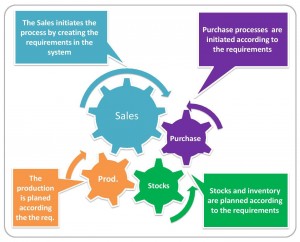The acronym for ERP is Enterprise Resource Planning. Thus planning is the name of the game. And this is exactly how an ERP software works.
But I will tell you one thing for sure – it will be long before you will start planning with the ERP software.
So how does the ERP system works? The ERP software has a significant role in an organization; it integrates all the different business entities together. And the beautiful thing about it is that it is all done with one program.
One of today’s illnesses of the business world is the inability to join together all the different business units under one umbrella. It all starts when the organization is relatively small and the different parts of the business start functioning in isolation;
the accounting has its own program for accounting because the law requires it; the salesman has its own MS word templates for offers and orders that he designs as he likes; the store man does it manually and the boss runs it all with Excel charts because he is an Excel expert.
Long before they realize it they create “information islands”. But after a few years the business is growing and the salesman has left and no one knows where the big order from last month is… This is no science fiction this is an everyday situation. It called the basket syndrome – an order is passed around the company from one basket to another.
Another side effect is expanding of the administrative work; the workers start to spend more and more time with activities that are detached from the core activities of the business and spend more time with administrative tasks. Try the next resource.
And this is the exact point of time when the ERP system assists an organization in handling these situations or new realities. Using the concept of integration of all business functions (finance/accounting, human resources, customer relationship management, manufacturing, project management, sales, supply chain management etc.) life is becoming easier for everyone.
The ERP system has several core principles and I will review them here in this article.
The main Goals of the ERP System
The ERP System is actually recording the working processes for several reasons – to collect data, to maintain flow of processes and to gain control.
After documenting the processes it facilitates transfer of data and information between the different departments in the organization.
With the ERP Software We are all in one Pot
 The ERP system binds all business entities together using the same databank. The easiest example is the customer or supplier data. Each individual in the organization will access the same customer’s or supplier’s details.
The ERP system binds all business entities together using the same databank. The easiest example is the customer or supplier data. Each individual in the organization will access the same customer’s or supplier’s details.
The different types of information (finance, sales, operational and etc.) will be available from one pot which is accessible for everyone and transparency becomes an important term in the organization.
ERP System stabilizes Processes
The ERP system provides the user with working tools. These working tools make sure that processes are maintained in the right way; the different forms and object make sure that information will be typed in the right place and on the right point of time for example, the creation of customer data.
When the users manage the details with an Excel chart you can be sure that telephone number will be entered in all kinds of formats. The ERP system will ensure that the phone number will be input in one format.
ERP Software integrates Processes
Most organizations revolve around the classic process – offer, order, delivery, invoicing with the accounting in the background. The ERP software centralizes the activities and operations and creates an efficient workflow between the different departments and functions; Sales, stocks, accounting. These processes are designed and developed according to business-specific best practices.
The “side effects” are transparency, automation of processes and reduction of human errors. After implementing the ERP software integration of the business departments is inevitable. The workflow initializes processes and transactions between different divisions and these are executed smoother and faster, and are less prone to human error.
On a higher level the organization develops external integration with it partners; suppliers and customers, by switching information and data with them.
Communication between the different Business Entities
Once the data is correctly typed or imported into the system, the different entities will starts to communicate with each more effectively. The communication is realized through the daily business activities.
Deliveries will not be sent to the wrong address or will be sent with open bills because everyone is fed with the relevant information and data from the same place; the address is correct and bookkeeping blocked the customer. Take a look at the next resource.


Comments are closed.